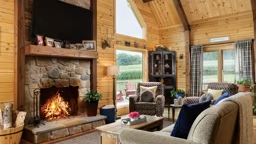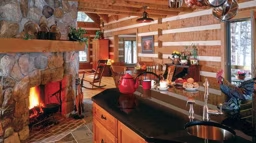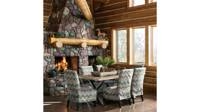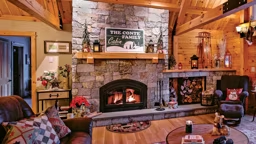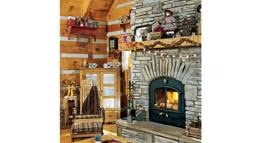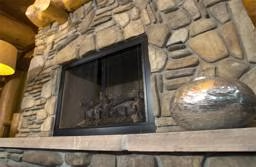
When it comes to cooking up some cozy warmth on a crisp fall day, home owner Sue Salvatori believes an old-fashioned wood fire is the key ingredient in the home-design recipe. "There's something very primal in its appeal," she says. However, when Sue and her husband Clement were ready to build their new 2,000-square-foot, two-story timber frame home north of San Luis Obispo, California, they hit a snag. Local regulations forbid traditional masonry fireplaces in all new housing. Disappointed but undaunted, the couple found a way to get what they wanted while still adhering to building codes: They simply added a portable wood-burning stove to 500 square feet of backyard deck instead. It's a great way to extend your living space," says Sue. "We love to entertain, and we host a huge party every January. It's really a perfect way to be comfortably warm and still enjoy our time outside. Plus, with all the downed tree branches each year, we have plenty of fuel." Creative solutions like Sue's have sparked a trend to move fireplaces beyond the great room to patios, family rooms anywhere warmth and ambiance are needed, according to Dan Kallal with Pacific Post & Beam, the Salvatoris' timber frame producer. "Fireplaces in the master bedroom are becoming more popular, and we had a couple recently install a combination wood-burning fireplace and pizza oven between their kitchen and great room," he says.
New Hearth Options
In years past, hearths were losing wall space to that other large glowing object in our homes?the TV. But with televisions retreating to their own rooms (aka, home theater systems), buyers are rediscovering the beauty and functionality of hearths. Among new home buyers, requests for hearths are only out-ranked by requests for kitchen upgrades, according to a 2003 survey of buying preferences by the National Association of Home Builders (NAHB) Research Center. But before you buy, ask yourself what you're shopping for. Do you want your fireplace to create ambiance, heat your home or both? If a heat-generating workhorse is what you're after, then shop for heat-rated units. They cost about 10 to 20 percent more than decorative units of the same size. If your primary concern is the look of the hearth, then you have a considerably more challenging decision ahead of you?maybe even multiple decisions. Why? Because buyers are increasingly interested in having more than one hearth in their homes, according the NAHB study. What areas are most popular? The master bedroom ranked first (33 percent of requests); the den, library, home office or study were second (14 percent); and the family room (10 percent) rounded out the top requests, according to the study. New shapes, sizes and styles of hearths also are fueling buyers' desire for fireplaces. See-through models enable home owners to install them in between rooms to increase viewing opportunities. This is a particularly popular option between master bedrooms and baths, as well as between the great room and an outside patio room. Buyers also are warming up to corner models for basement game and guest rooms, as well as for the home offices or dens. Peninsula models, which are open on three sides, often are used as room dividers in open-style floorplans, such as between the kitchen and dining area. Oasis-style hearths, open on all four sides, have become centerpieces for poolside cabanas and patios. New technology in venting options and fuels gives consumers a greater choice in location both inside and outside the home. Depending on the fuel used, hearths are vented in three ways: natural draft (vented through the roof, such as a chimney), direct vent and vent-free. Direct vent units are the most common gas-burning units, because they vent directly through an exterior wall, dramatically reducing costs for materials and installation when compared to roof venting. The term "vent-free" refers to gas-fired hearths that burn so efficiently the need for venting is eliminated. (Use of this type of unit is limited to certain regions of the country due to building-code restrictions.)Deliberate Design
Adding a hearth to a room usually means that you'll use the space more often. "Adding a fireplace to a dark, remote or formal space will automatically transform the room into a romantic gathering spot," according to architect Dennis Wedlick, author of Good House Parts: Creating a Great Home Piece by Piece. If you think you want to include a hearth in your timber frame home, it's best to consider its placement when you're still in the design stage. For example, the chimney of a traditional masonry fireplace should be placed either completely within the timber frame's structure or on the exterior of the frame, so it won't interfere with the frame's structural design. You also need to plan for the stress of the stones' weight on your floor. Sometimes a reinforced subfloor is necessary. On a less structural, more design-oriented note, you'll need to consider the flow of your floorplan. Consult with a design professional to help you locate the perfect spot for your fireplace so that it meets your entertainment needs and doesn't conflict with window views and traffic flow. "Remember that it's the life that happens in front of the hearth that's really important. That's where the design focus should be, not on the hearth itself," advises Wirt C. Whitaker, an architect and independent representative for Timberpeg in Westerville, Ohio. So that the hearth doesn't eat into a home's usable square footage, some designers have placed a wood-burning fireplace and chimney in its own nook, protruding outside the home's basic design. But many designers, as well as the Hearth, Patio and Barbecue Association (HPBA), discourage this configuration today, siting that it can lead to problems, including poor energy efficiency, back-drafting and smoke leaking back into the home. Another configuration that's falling out of favor is flanking a fireplace with windows. "This technique was used to incorporate the view with the fireplace. But since you use the fireplace mainly at night, your windows turn into giant mirrors," according to architect Bill Roseberry of Sunlit Architecture in Crested Butte, Colorado.Fuel to the Fire
The fuel sources that are accessible to you (or are allowed by local building codes) will impact your buying decision. There are eight fuels to choose from; firewood, natural gas, propane, coal, oil, electricity, wood pellets and grain (usually corn). You can burn these fuels in fireplaces, stoves, masonry heaters or inserts (retrofit for existing fireplaces). With so many choices in hearth appliances, you'll need to narrow your options. Wood is the king of the fuel choices, accounting for 64 percent of hearth sales nationwide. New sophisticated designs have doubled the energy efficiency and reduced the amount of smoke emitted by wood-burning units. Plus, the Environmental Protection Agency now certifies most of them. However, tending a wood fire is a labor of love?until it turns into a laborious chore. That's why gas hearths have grown in popularity. Convenience is the big draw. After all, you can have a warm fire at the touch of a switch, thermostat or even remote-control button. Many modern units even match or beat the energy-efficiency rating of your furnace. But often, choosing between wood and gas is difficult. "That's why an increasing number of home buyers are adding multiple hearths to their homes," says John Crouch, director of public affairs for the HPBA. Home owners sometimes choose a gas fireplace in more formal areas for its efficiency and convenience, then install a wood-burning unit in a less formal area like a family room or den. What if heat isn't important to you? Perhaps you live in a warm climate but you still want the ambiance of a fire. Then an electric hearth may be the right solution. "Electric hearths have really taken off in popularity in the past three years," says Tracy Shull, product manager for Heatilator Brand Hearth & Home Technologies in Mount Pleasant, Iowa. "The reason is economical versatility. You can place them inside an interior wall, in a corner application, wherever."And if you live in corn country, a grain-fired unit may make sense for you. These are far cheaper to operate than natural gas, and corn doesn't require splitting or stacking. "It only takes four months to grow a crop of corn but it takes 40 years to grow trees," says Mark Tunsing with Golden Grain Corn Stoves in Merino, Colorado.Final Factors
When shopping for any big-ticket item, cost is always a consideration. Prices for traditional masonry fireplaces will vary greatly, depending on region, chimney size and the type of rock or brick you choose?not to mention labor. Costs for factory-produced hearths, in contrast, are remarkably competitive, regardless of the fuel they use. Prices range from less than $1,000 to more than $4,000 (not including installation or venting costs), depending on unit size and heating capacity. And then there's the cost for accessories (mantels, facings, screens, tool sets and rugs), which can climb into the many thousands, depending on what look you want to achieve. But your family's health is something you can't put a price on and must consider when weighing your options. Why? If someone in your family has allergies, your best bet may be a sealed unit that doesn't allow smoke or contaminants to re-enter your home. Dry air also can be a health issue, because it promotes the growth of some bacteria, viruses and respiratory irritants. You may want to combine your hearth with a filtration or humidifier system to keep pollutants to a minimum. As you shop the vast selection of hearth options, be sure to talk to each sales rep about your climate, floorplan and lifestyle needs to ensure you have the right strategy for your home. With careful consideration and thoughtful planning, you can keep the home fires burning all winter long<
High-Styling Hearths
Once upon a time, you were limited when it came to the style and look of your hearth?masonry was the only way to go. Today, there's no end to the choices that are available. And as technology advances, the options just keep growing and growing. Here are a few of the innovative ideas hearth-product manufacturers offer to increase the cozy-factor in your timber frame home.1 Interested in adding drama to an outdoor patio? Travis Industries' Ring of Fire can fit the bill. This single outdoor unit puts forth a simultaneous burst of fountain and flame that's sure to wow everyone who visits.
2 Looking for a contemporary alternative to logs for your gas fireplace? Insert specially made glass (about $260) from Fire On Ice, which not only provides a dramatic look unlike anything on the market, the glass holds heat for hours after you turn off the fireplace, increasing energy efficiency, according to Ed Jaunzemis, owner of Fire On Ice.
3 Want the look of a masonry fireplace without the cost? Heat-N-Glo has eliminated the sheet metal trim and louvers surrounding a gas fireplace, creating a look that was previously only available from a mason.
4 Hoping to have a hearth in the kitchen? Heat-N-Glo's Crescent model is an arched-style gas-fired design reminiscent of a Rumford fireplace, It's the first fireplace specifically designed with the kitchen in mind, boasting a flip-down warming shelf. The larger Escape model features a seamless firebox with the incredible realism of dry-stacked brick.
5 Have a difficult location? The Infinity gas fireplace from Heat-N-Glo utilizes a patent-pending draft-assist system that allows venting up to 90 feet with as many as eight 90-degree turns in its smaller "slim line" vent pipe. "This is five times longer than most gas fireplaces, enabling installation in even the most difficult of settings," says Ross Morrison with Heat-N-Glo.
6 Are you concerned about respiratory issues? Heat-N-Glo has also pioneered the FreshAir gas hearth. This unit sports a heat-recovery ventilator that brings fresh air in while exhausting stale room air.
7 Want to use alternative fuel sources? Pellet stoves are powered by recycled sawdust compressed into small, burnable nuggets. However, some buyers of early models were dissatisfied with actual size of the units' flames. But pellet stoves needn't produce candle-like fire displays. The Harman Stove Company recently won an award for innovation from Hearth & Home Magazine for its impressive fire display in its P68 pellet stove.
Story by Charles Bevier




